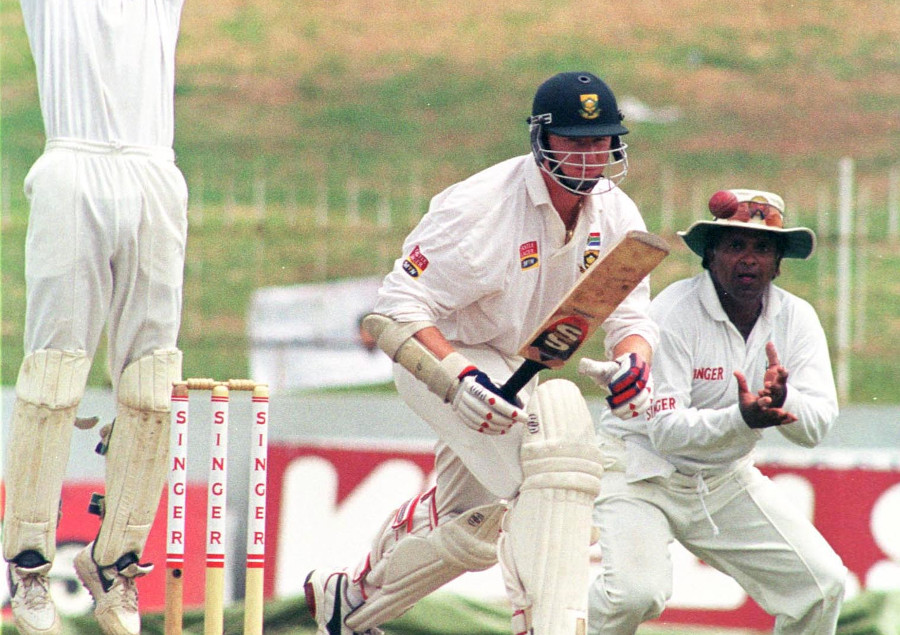In 131 years, South Africa have played 439 Test matches and won 165 in total, but just four of those have come by a margin of fewer than 20 runs.
The scope of Test cricket makes incredibly tight matches an infrequent occurrence.
Here, we look at the circumstances surrounding the four narrowest South African Test-match victories by runs.
- South Africa (208, 345) beat England (310, 224) by 19 runs in Johannesburg, 1910
The South Africa XI got off to a shaky start after Tip Snooke won the toss and elected to bat first, losing openers Billy Zulch and Louis Stricker early. A century partnership between Aubrey Faulkner and Dave Nourse reset them for a decent total, but their dismissals prompted a collapse. South Africa were bowled out for 208 on day one and, at stumps, England were 147 without loss.
Play broke for a rest day on Sunday, 2 January 2010, and when it resumed, the South Africans came out fighting. Bert Vogler’s trickery accounted for both Wilfred Rhodes and Sir Jack Hobbs. Vogler and Faulkner took an even split of the English scalps, and though England established a 102-run lead, it could have been worse after the great start the tourists got.
South Africa lost their first three wickets while still in arrears, but Faulkner again came to the fore, scoring the first of his four Test centuries. He shared a 99-run stand with skipper Snooke and rallied the lower order to give the hosts a fighting chance of victory.
Vogler decimated the England top order in response, and by the close of play on day three the visitors were in disarray at 144-7. England captain Sir Henry Leveson Gower and George Thompson stuck around, though, giving them a shot at victory, but Faulkner came through once more. Faulkner bowled Thompson to seal the victory and allow South Africa to take a 1-0 lead in a series they went on to win 3-2.
- South Africa (340, 142) beat England (251, 214) by 17 runs in Johannesburg, 1957
In a well-established tradition, South Africa won the toss and elected to bat first, and Trevor Goddard and Johnny Waite put the hosts in charge on the first morning. Roy McLean fell just seven runs short of what would have been his second century of the series.
England captain Peter May and vice-captain Doug Insole were well set until the latter was run out. May was cleaned up by Neil Adcock shortly afterward and England slid from 131-2 to 251 all out.
South Africa’s second innings effort let the tourists back into the game, as the middle order gave way after the departure of Goddard.
England were chasing 232 runs to win. On the final day, Hugh Tayfield bowled unchallenged with unerring accuracy. The off-spinner claimed South African record figures of 9-113 as England caved under the pressure he built.
- South Africa (253, 231) beat Sri Lanka (308, 169) by seven runs in Kandy, 2000
Sri Lanka won the toss and put South Africa in to bat, and when the tourists found themselves 35-5 it seemed to have been the right decision. Lance Klusener came into the series in great form with the bat, though, and launched an incredible counter-attack. Klusener hit 118 before running out of partners.
A Marvan Atapattu century allowed Sri Lanka to regain the initiative and build a first-innings lead that left Shaun Pollock’s team on the ropes.
Jacques Kallis played a typically stoic knock for South Africa in a second-innings effort, but the runs eked out by Nicky Boje and Paul Adams proved critical.
Pollock and Mornantau Hayward struck early to rock the Sri Lanka effort, but Russell Arnold and Arjuna Ranatunga got together in a threatening partnership. Boje got the breakthrough when he trapped Arnold lbewe, and Klusener pressed home the advantage. Ranatunga took just 36 balls to reach his 50, though, and seemed determined to hit Sri Lanka to victory. Ranatunga tamely pushed Boje to short-leg, however, after Klusener helped put the brakes on the Sri Lankan effort and the hosts lost their last three wickets for eight runs. The partisan crowd did not take the defeat well, pelting the umpires with plastic bottles.
- South Africa (169, 239) beat Australia (292, 111) by five runs in Sydney, 1994

Perhaps one of South Africa’s greatest cricketing comebacks came in Sydney in 1994. The enduring image associated with the contest is Fanie de Villiers’ final wicket celebration. The performance is held up as an excellent example of the resilience that South African cricket dearly prizes.
Shane Warne tore through the South African middle order, claiming seven wickets as the tourists were skittled for just 169.
Australia built a 123-run lead, with Michael Slater falling eight runs short of a ton and Damien Martyn chipping in with a 50.
In their second innings, South Africa were in trouble again, losing five wickets for 110 runs. De Villiers will be remembered as the hero of the match, but his brilliant match-winning spell would not have been possible without Jonty Rhodes’ 76 not out that gave the bowlers something to work with.
That something wasn’t much, and the target of 117 remains the lowest South Africa have successfully defended in the fourth innings. Australia were 63-4 overnight and appeared to be on course to take a series lead. Some lusty blows from Craig McDermott nearly got Australia over the line, but South Africa stuck it out and secured a famous win.
Photo: Getty Images







